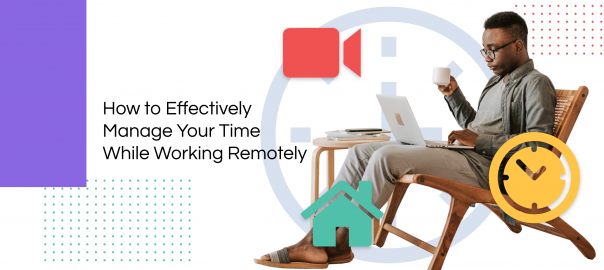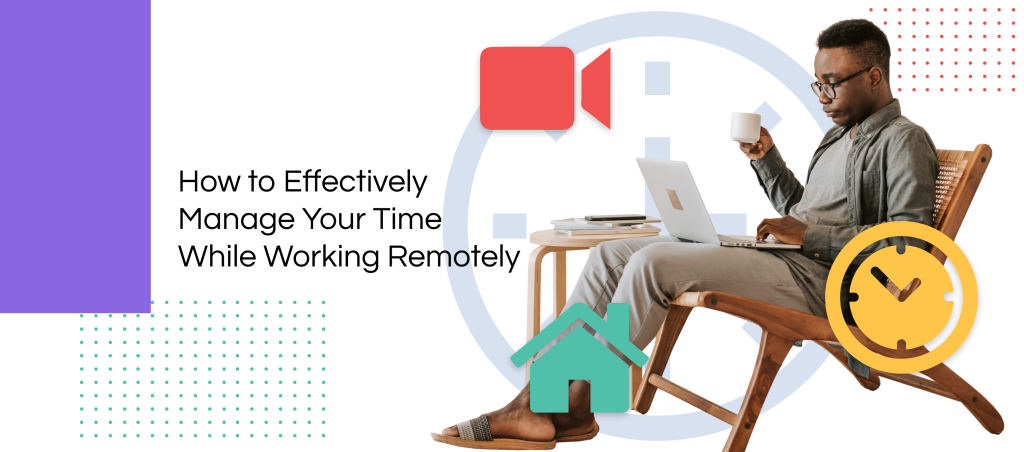To efficiently manage your time while working remotely, set clear goals and prioritize tasks daily. Use time-tracking tools to stay focused and productive.
Working remotely offers flexibility but can also lead to distractions. To stay productive, establish a dedicated workspace free from interruptions. Create a daily schedule, allocating specific time blocks for tasks. Use tools like Trello or Asana to organize and track your tasks.
Take regular breaks to avoid burnout and maintain high energy levels. Communicate effectively with your team using tools like Slack or Zoom to ensure smooth collaboration. By setting clear goals and prioritizing tasks, you can efficiently manage your time and stay productive while working remotely.

Credit: creately.com
Creating A Dedicated Workspace
Creating a dedicated workspace is crucial for efficient remote work. A well-planned workspace boosts productivity and reduces stress. Let’s explore how to set up an ideal workspace.
Choosing The Right Spot
Selecting the right spot for your workspace is essential. Choose a quiet area with good lighting. Natural light is preferable as it enhances mood and energy.
Avoid high-traffic areas in your home. This reduces interruptions and distractions. Make sure your spot has a stable internet connection. This ensures smooth communication and workflow.
Minimizing Distractions
Minimizing distractions is key to staying focused. Start by keeping your workspace tidy. A clean desk helps you concentrate better.
Use noise-cancelling headphones to block out background noise. Inform family members about your work hours. This helps in reducing unnecessary interruptions.
Disable notifications on your devices during work hours. This helps you stay focused on tasks. Place your phone away from your desk to avoid temptation.
| Distraction | Solution |
|---|---|
| Noise | Noise-cancelling headphones |
| Family Interruptions | Set work hours |
| Phone Notifications | Disable notifications |
| Clutter | Keep workspace tidy |
Creating a dedicated workspace is about optimizing your environment. Make sure it’s comfortable, organized, and free from distractions. This way, you can work efficiently and effectively from home.
Establishing A Routine
Working remotely can be a challenge if you don’t have a routine. A routine helps you stay focused and productive. It ensures you have a clear plan for your day. Let’s explore how to establish an effective routine.
Setting Regular Hours
Set regular working hours to create a boundary between work and home. Consistent hours help your mind know when it’s work time. Stick to these hours every day. This will make your work more structured.
| Task | Time |
|---|---|
| Start Work | 9:00 AM |
| Morning Tasks | 9:00 AM – 12:00 PM |
| Lunch Break | 12:00 PM – 1:00 PM |
| Afternoon Tasks | 1:00 PM – 5:00 PM |
| End Work | 5:00 PM |
This table is an example of a workday schedule. Adjust it based on your needs.
Incorporating Breaks
Taking breaks is crucial for maintaining energy and focus. Short breaks help your brain rest. Plan to take a 5-minute break every hour. This can be a quick stretch or a walk around your house.
- Morning Break: 10:00 AM – 10:05 AM
- Lunch Break: 12:00 PM – 1:00 PM
- Afternoon Break: 3:00 PM – 3:05 PM
Use these breaks to relax and recharge. This will make you more productive when you return to work.
Prioritizing Tasks
Working remotely can be challenging. One of the biggest challenges is managing your time. Prioritizing tasks is key to staying productive. It helps you focus on what matters most.
Using A Task List
Start each day with a task list. Write down all tasks you need to do. This gives you a clear picture of your workload.
Here are some tips for creating an effective task list:
- Be specific: Write clear, detailed tasks.
- Set deadlines: Assign due dates to each task.
- Prioritize: Rank tasks by importance.
An organized task list helps you stay on track. It reduces stress and increases productivity.
Applying The Eisenhower Matrix
The Eisenhower Matrix is a powerful tool. It helps you prioritize tasks based on urgency and importance. The matrix has four quadrants:
| Quadrant | Description |
|---|---|
| Urgent and Important | Tasks you must do immediately. |
| Important but Not Urgent | Tasks you need to schedule. |
| Urgent but Not Important | Tasks you should delegate. |
| Not Urgent and Not Important | Tasks you should eliminate. |
Using this matrix helps you focus on what truly matters. It prevents you from wasting time on trivial tasks.

Credit: www.instagram.com
Utilizing Technology
Working remotely presents unique challenges. But utilizing technology can make time management easier. Various apps and tools help you stay productive and organized.
Time Management Apps
Time management apps help you keep track of tasks and deadlines. They assist in organizing your day efficiently.
- Todoist: This app lets you create task lists and set deadlines. It syncs across all devices.
- Trello: Trello uses boards, lists, and cards to organize tasks. It’s great for visual planning.
- RescueTime: This app tracks your time spent on different tasks. It provides insights to improve productivity.
Productivity Tools
Productivity tools enhance your workflow. They help you stay focused and efficient.
- Slack: This tool facilitates team communication. It integrates with other apps for seamless collaboration.
- Zoom: Zoom is essential for virtual meetings. It offers high-quality video and audio conferencing.
- Asana: Asana helps manage projects and tasks. It allows you to assign tasks and track progress.
Combining these apps and tools can boost your productivity. They help you manage your time more effectively while working remotely.
Effective Communication
Effective communication is essential for managing time while working remotely. It helps team members understand tasks clearly. Good communication ensures everyone stays on the same page. This reduces misunderstandings and boosts productivity.
Regular Check-ins
Regular check-ins are crucial for remote teams. They help keep track of progress and address any issues early. Schedule daily or weekly meetings to discuss updates. Use video calls, chats, or emails for these check-ins.
| Tool | Purpose |
|---|---|
| Zoom | Video Meetings |
| Slack | Instant Messaging |
| Detailed Updates |
Clear Guidelines
Setting clear guidelines is vital for remote work success. Define tasks and deadlines precisely. Use bullet points to list steps for complex tasks. Provide examples to clarify expectations.
- Write task instructions.
- Set specific deadlines.
- Give examples.
Clear guidelines help team members know exactly what to do. This minimizes confusion and saves time.

Credit: www.linkedin.com
Balancing Work And Personal Life
Remote work offers flexibility but can blur the lines between work and personal life. It’s essential to find a balance to stay productive and happy. Here are some strategies to help you manage your time effectively.
Setting Boundaries
Boundaries are crucial in separating work from personal life. Start by creating a dedicated workspace. This helps you focus during work hours. Use physical and mental cues to switch between work and relaxation.
- Dedicated Workspace: Designate a specific area for work.
- Work Hours: Stick to a consistent schedule.
- Break Times: Take regular breaks to rest your mind.
Communicate your work hours with family and friends. This helps them understand when you are unavailable. Use tools like “Do Not Disturb” mode to minimize interruptions.
Scheduling Downtime
Downtime is essential for mental and physical health. Schedule it as you would a meeting. Plan activities that help you unwind and recharge.
| Activity | Time |
|---|---|
| Exercise | 30 minutes daily |
| Reading | 1 hour before bed |
| Family Time | 2 hours in the evening |
Use a planner or calendar to block out your downtime. This ensures you have time for yourself and your loved ones.
Remember to disconnect from work emails and notifications during these periods. This helps you fully enjoy your personal time.
Staying Motivated
Working remotely offers great flexibility, but it can be hard to stay motivated. Without proper motivation, productivity can dip. Here are some effective ways to stay motivated while working remotely.
Setting Goals
Setting clear, achievable goals is essential. Goals give you direction and purpose. You can set daily, weekly, and monthly goals. This keeps you on track and helps you measure progress.
- Daily goals: Simple tasks you can complete in one day.
- Weekly goals: Larger tasks divided into daily actions.
- Monthly goals: Long-term projects broken into weekly parts.
Use a planner or digital tool to track your goals. Review and update them regularly. This keeps your goals fresh and relevant.
Rewarding Yourself
Rewards are great motivators. They give you something to look forward to. You can reward yourself after completing tasks.
- Small rewards for daily goals: A snack, a short walk, or a quick game.
- Medium rewards for weekly goals: A movie night, a nice meal, or a hobby activity.
- Big rewards for monthly goals: A weekend trip, a new gadget, or a special treat.
Rewards make work more enjoyable. They also help you maintain a positive attitude. Remember to choose rewards that are meaningful to you.
Continuous Improvement
Working remotely requires effective time management. Continuous improvement is key. It helps in refining your time management skills. By regularly assessing your performance, you can identify areas for growth and make necessary changes.
Reflecting On Your Day
At the end of each day, take a moment to reflect. Ask yourself a few questions:
- Did I complete my tasks?
- Were there any distractions?
- How did I handle unexpected challenges?
Write down your answers. This helps in recognizing patterns in your work habits. You can see what works and what doesn’t.
By understanding your daily performance, you can make better decisions. This will lead to improved productivity.
Adjusting Strategies
Based on your reflections, adjust your strategies. Here are some tips:
- Prioritize tasks: Focus on the most important tasks first.
- Set time limits: Allocate specific times for each task.
- Eliminate distractions: Identify and remove sources of interruptions.
- Use productivity tools: Tools like Trello or Asana can help you stay organized.
Remember, it’s about finding what works best for you. Make small changes and observe their impact. This will lead to continuous improvement in your time management skills.
Frequently Asked Questions
How Can I Stay Focused While Working Remotely?
Staying focused while working remotely requires setting clear goals. Create a dedicated workspace. Minimize distractions by using productivity tools. Take regular breaks to recharge. Establish a routine to maintain consistency.
What Are Some Time Management Tips For Remote Workers?
Use a task management app to organize your workload. Prioritize tasks based on importance and deadlines. Set specific work hours. Avoid multitasking and focus on one task at a time. Review your progress daily.
How Can I Avoid Burnout While Working From Home?
To avoid burnout, set boundaries between work and personal time. Take regular breaks. Practice self-care by exercising and eating healthily. Stay connected with colleagues through virtual meetings. Make time for hobbies and relaxation.
How Do I Handle Interruptions During Remote Work?
To handle interruptions, communicate your work hours to family and housemates. Use noise-cancelling headphones. Schedule specific times for household chores. Create a “do not disturb” signal for your workspace. Address urgent interruptions promptly.
Conclusion
Mastering time management while working remotely boosts productivity. Implement these tips to stay organized and focused. Prioritize tasks, set boundaries, and take regular breaks. Efficient time management leads to a balanced work-life experience. Start implementing these strategies today for a more productive remote work environment.

